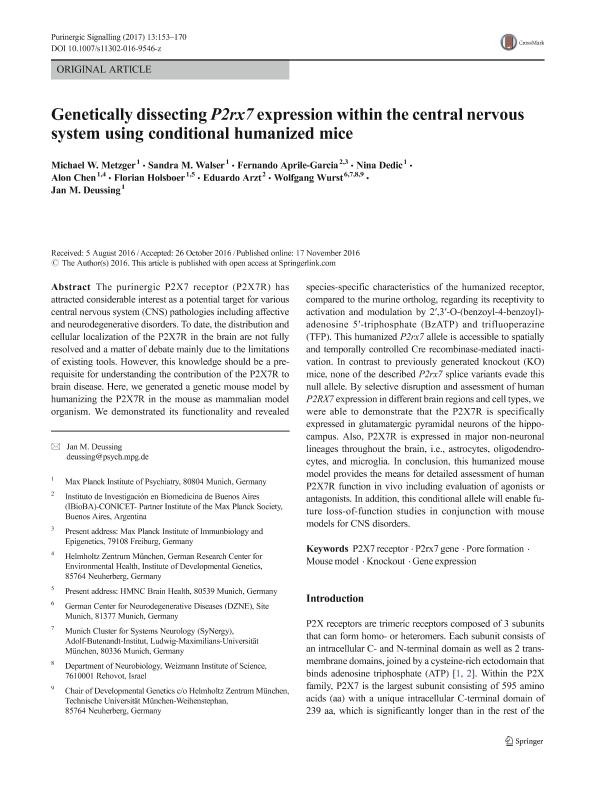Mostrar el registro sencillo del ítem
dc.contributor.author
Metzger, Michael W.
dc.contributor.author
Walser, Sandra M.
dc.contributor.author
Aprile García, Fernando

dc.contributor.author
Dedic, Nina
dc.contributor.author
Chen, Alon
dc.contributor.author
Holsboer, Florian
dc.contributor.author
Arzt, Eduardo Simon

dc.contributor.author
Wurst, Wolfgang
dc.contributor.author
Deussing, Jan M.
dc.date.available
2018-06-29T17:10:39Z
dc.date.issued
2017-06
dc.identifier.citation
Metzger, Michael W.; Walser, Sandra M.; Aprile García, Fernando; Dedic, Nina; Chen, Alon; et al.; Genetically dissecting P2rx7 expression within the central nervous system using conditional humanized mice; Springer; Purinergic Signalling; 13; 2; 6-2017; 153-170
dc.identifier.issn
1573-9538
dc.identifier.uri
http://hdl.handle.net/11336/50671
dc.description.abstract
The purinergic P2X7 receptor (P2X7R) has attracted considerable interest as a potential target for various central nervous system (CNS) pathologies including affective and neurodegenerative disorders. To date, the distribution and cellular localization of the P2X7R in the brain are not fully resolved and a matter of debate mainly due to the limitations of existing tools. However, this knowledge should be a prerequisite for understanding the contribution of the P2X7R to brain disease. Here, we generated a genetic mouse model by humanizing the P2X7R in the mouse as mammalian model organism. We demonstrated its functionality and revealed species-specific characteristics of the humanized receptor, compared to the murine ortholog, regarding its receptivity to activation and modulation by 2′,3′-O-(benzoyl-4-benzoyl)-adenosine 5′-triphosphate (BzATP) and trifluoperazine (TFP). This humanized P2rx7 allele is accessible to spatially and temporally controlled Cre recombinase-mediated inactivation. In contrast to previously generated knockout (KO) mice, none of the described P2rx7 splice variants evade this null allele. By selective disruption and assessment of human P2RX7 expression in different brain regions and cell types, we were able to demonstrate that the P2X7R is specifically expressed in glutamatergic pyramidal neurons of the hippocampus. Also, P2X7R is expressed in major non-neuronal lineages throughout the brain, i.e., astrocytes, oligodendrocytes, and microglia. In conclusion, this humanized mouse model provides the means for detailed assessment of human P2X7R function in vivo including evaluation of agonists or antagonists. In addition, this conditional allele will enable future loss-of-function studies in conjunction with mouse models for CNS disorders.
dc.format
application/pdf
dc.language.iso
eng
dc.publisher
Springer

dc.rights
info:eu-repo/semantics/openAccess
dc.rights.uri
https://creativecommons.org/licenses/by-nc-sa/2.5/ar/
dc.subject
Gene Expression
dc.subject
Knockout
dc.subject
Mouse Model
dc.subject
P2rx7 Gene
dc.subject
P2x7 Receptor
dc.subject
Pore Formation
dc.subject.classification
Inmunología

dc.subject.classification
Medicina Básica

dc.subject.classification
CIENCIAS MÉDICAS Y DE LA SALUD

dc.title
Genetically dissecting P2rx7 expression within the central nervous system using conditional humanized mice
dc.type
info:eu-repo/semantics/article
dc.type
info:ar-repo/semantics/artículo
dc.type
info:eu-repo/semantics/publishedVersion
dc.date.updated
2018-06-19T15:56:13Z
dc.identifier.eissn
1573-9546
dc.journal.volume
13
dc.journal.number
2
dc.journal.pagination
153-170
dc.journal.pais
Alemania

dc.journal.ciudad
Berlin
dc.description.fil
Fil: Metzger, Michael W.. Max Planck Institut Fur Psychiatrie; Alemania
dc.description.fil
Fil: Walser, Sandra M.. Max Planck Institut Fur Psychiatrie; Alemania
dc.description.fil
Fil: Aprile García, Fernando. Consejo Nacional de Investigaciones Científicas y Técnicas. Oficina de Coordinación Administrativa Parque Centenario. Instituto de Investigación en Biomedicina de Buenos Aires - Instituto Partner de la Sociedad Max Planck; Argentina
dc.description.fil
Fil: Dedic, Nina. Max Planck Institut Fur Psychiatrie; Alemania
dc.description.fil
Fil: Chen, Alon. Helmholtz Center Munich German Research Center For Environmental Health; Alemania. Max Planck Institut Fur Psychiatrie; Alemania
dc.description.fil
Fil: Holsboer, Florian. Max Planck Institut Fur Psychiatrie; Alemania
dc.description.fil
Fil: Arzt, Eduardo Simon. Consejo Nacional de Investigaciones Científicas y Técnicas. Oficina de Coordinación Administrativa Parque Centenario. Instituto de Investigación en Biomedicina de Buenos Aires - Instituto Partner de la Sociedad Max Planck; Argentina
dc.description.fil
Fil: Wurst, Wolfgang. Ludwig Maximilians Universitat; Alemania. Weizmann Institute Of Science Israel; Israel. Universitat Technical Zu Munich; Alemania
dc.description.fil
Fil: Deussing, Jan M.. Max Planck Institut Fur Psychiatrie; Alemania
dc.journal.title
Purinergic Signalling

dc.relation.alternativeid
info:eu-repo/semantics/altIdentifier/doi/http://dx.doi.org/10.1007/s11302-016-9546-z
dc.relation.alternativeid
info:eu-repo/semantics/altIdentifier/url/https://link.springer.com/article/10.1007%2Fs11302-016-9546-z
Archivos asociados
